

Learning 3.0 and the Smart eXtended Web. The Smart eXtended Web. New culture of learning. Digitaaliajan opettaja. Educalonka2013. Lonka minerva2013. Lonka ewf2013. What Does Web3.0 Mean to Education? This is an interview of EdTech Magazine with Karen Cator, first published here : What Is Web 3.0, Really, and What Does It Mean for Education?
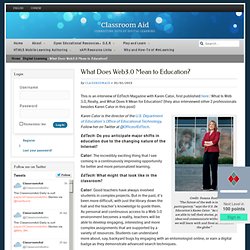
(they also interviewed other 2 professionals besides Karen Cator in this post) Credit: Susana Raab“The future of the web is incredibly participatory,” says the U.S. Department of Education’s Karen Cator. “As more people are able to tell their stories, publish their ideas and communicate without barriers, we will learn with and from all corners of the globe.”
Karen Cator is the director of the U.S. EdTech: Do you anticipate major shifts in education due to the changing nature of the Internet? New Pedagogies For the Digital Age. 15 Habits For Learning In The 21st Century 10.89K Views 0 Likes Defining 21st century skills is an editorial matter, but part of a larger, important conversation. How has learning changed in the 21st century? Here's our take. How To Improve Learner Engagement With eLearning Software 5.05K Views 0 Likes Interaction and learner engagement have long been recognized for their critical role in the learning process. How A Tornado Inspired Innovation In Joplin, MO Schools 5.84K Views 0 Likes. Herätyskellomafia.
Manifesto for education change. (This article is a compilation of tweets – feel free to add your comments and questions and advance the conversation.)

Imagine Learning Manifesto for education change #edchat #education #cpchat The world is changing rapidly. Regrettably, education is not keeping pace with change. We need to re-think education. A Bill of Rights and Principles for Learning in the Digital Age. Preamble Work on this Bill of Rights & Principles began in Palo Alto, California, on December 14, 2012.

We convened a group of people passionate about learning, about serving today's students, and about using every tool we could imagine to respond better to the needs of students in a global, interactive, digitally connected world. The Internet has made it possible for anyone on the planet to be a student, a teacher, and a creative collaborator at virtually no cost. Novel technologies that can catalyze learning are bubbling up in less time than it takes to read this sentence.
Some have emerged from universities, some from the private sector, some from individuals and digital communities. The 7 Most Powerful Ideas In Learning Available Right Now. Tomorrow’s Learning Today: 7 Shifts To Create A Classroom Of The Future by Terry Heick For professional development around this idea or others you read about on TeachThought, contact us.
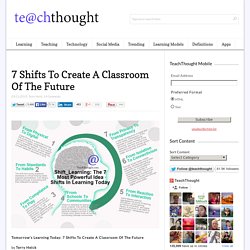
Let’s take a look at the nebulous idea of the “classroom of the future.” This is all subjective, but it’s worth talking about. So let’s talk. Three Trends That Will Shape the Future of Curriculum. Big Ideas Culture Digital Tools Teaching Strategies What we as adults experienced in school, as educators and students, will bear little resemblance to what lies ahead.
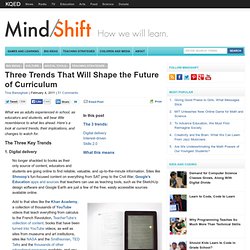
Here’s a look at current trends, their implications, and changes to watch for. The Three Key Trends 1. Viisaus, sosiaalisuus, ihmiseksi kasvaminen. Työelämässä vastuu, vapaus; heikon signaalin herkkyys.
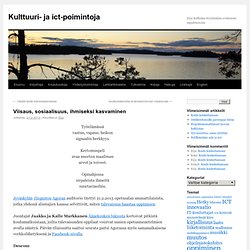
Kertomuspeli avaa nuorten maailman arvot ja toiveet. Opinahjossa sirpaleista ihmeitä suurtarinoihin. Tulevaisuus haastaa oppimisen 2013 — Moniviestin. Tulevaisuus haastaa oppimisen 2013 - Osa 6 — Moniviestin. Muutos on todellisuuden kieli - Mitä tänään opin. 7 Characteristics Of Future Learning. Reading, in terms of scale and diversity, is different than it used to be.
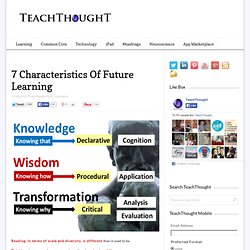
Thinking, in terms of context and application, is also different. It makes since that learning is also changing–becoming more entrepreneurial than directly didactic. That is, more learner-centered and controlled than teacher-and-report-card controlled. The presentation below by Steven Wheeler explores some of the shifts occurring in our digital age. Clarifying the differences between knowledge, wisdom, and critical awareness was an excellent way to frame the presentation. The Road to Successful Learning is Paved With Mistakes. Today’s educators are quite concerned that our present educational system still has a long way to go in terms of providing a successful learning experience for students of all ages. Nowhere is this more evident than in the short film here, produced by Ericsson, and featuring some forward-thinking individuals who are hoping that the future will build on past mistakes and achievements to build a brighter educational future: We Can No Longer Utilize 20th Century Learning Techniques It is a foregone conclusion that technology must be utilized in order to ensure that every learner gets the most out of his or her educational opportunities.
Teachers will always play a valuable role in learning, but they need to start teaching learners to be independent thinkers, rather than spoon-feeding them information that will only be regurgitated on a standardized test. Oppiminen on leikin asia. Leikkiminen ei ole pelkästään hyväksi ihmiselle. Skills for Learning 2.0. 15 Ways Digital Learning Can Lead To Deeper Learning. How To Use Mood Boards For Visual Learning 4.70K Views 0 Likes Mood boards are used for photography, game design, interior design, marketing, fashion, music, advertising and even architecture; but who’s to say they shouldn’t be used in the classroom? (You might be doing this already!)
Teromakoteron blogi. Why Curation Will Transform Education and Learning: 10 Key Reasons. There is a growing number of key trends that are both rapidly revolutionizing the world of education as we know it and opening up opportunities to review and upgrade the role and scope of many of its existing institutions, (as the likeliness that they are going to soon become obsolete and unsustainable, is right in front of anyone's eyes).
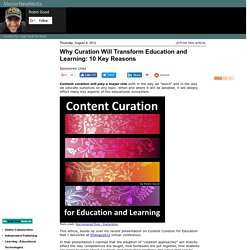
George Siemens, in his recent Open Letter to Canadian Universities, sums them up well: 1) An Overwhelming Abundance of Information Which Begs To Be OrganizedThe goal is not (and probably it never was) to learn or memorize all of the information available out there. It's just too much even if we focus only on the very essence of it. Learning in Networks of Knowledge. Humanrithm: why data without people is not enough.
The Human Algorithm: Redefining the Value of Data. InShare246. 14 Currencies For the Digital Learner. The Kinds Of Skills That Transcend Content Areas by Terry Heick Traditionally, learning is formatted by content, and that content formatted again by content areas (usually reading, writing, math, science, and social studies).
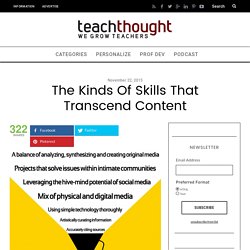
Learning is evolving–and not simply by the tools that actuate it. The process of adopting new learning domains and materials–many digital–has exposed the need for new skills. Pearltrees.
Opettajien TVT-taidot ja opetuskulttuuri: selvä ongelma ja selvä ratkaisu. Sometek. Real-World, Self-Directed. Future Learning Short Documentary. JSB. ¿Qué es la nueva cultura del aprendizaje? La nueva cultura del aprendizaje es adaptarse a los cambios y buscar nuevas formas de aprender a través de la innovación, cultivar la imaginación y aprender haciendo.

Según el profesor Douglas Thomas su objetivo principal es buscar un equilibrio entre la estructura institucional y la libertad individual. En la actualidad surgen nuevas propuestas y proyectos de aprendizaje que hacen uso de las herramientas tecnológicas en ambientes no tradicionales. The Similarities Between Montessori And Digital Learning. The Similarities Between The Montessori And Digital Learning by Carri Schneider first appeared on gettingsmart.com “Before elaborating any system of education, we must therefore create a favorable environment that will encourage the flowering of a child’s natural gifts. All that is needed is to remove the obstacles.
And this should be the basis of, and point of departure for, all future education.” Maria Montessori, The Secret of Childhood, 1936 At first glance, the intersections between Montessori education and high-quality digital learning are not immediately apparent. Steve Wozniak at TEDxBrussels. Noam Chomsky on the Purpose of Education. By Maria Popova On the value of cultivating the capacity to seek the significant. In this talk based on his presentation at the Learning Without Frontiers conference in January, philosopher, linguist, and cognitive scientist Noam Chomsky — easily one of our time’s sharpest thinkers — discusses the purpose of education.
Despite the slow pace and the cheesy AfterEffects animated typography, the video is a treasure trove of insight on everything from the role of technology to the pitfalls of policy. Isaac Asimov on Creativity in Education & The Future of Science. RSA Animate - Changing Education Paradigms. Sir Ken Robinson on the Power of the Imaginative Mind (Part One) Ken: Good evening. Education reform is, I think, now the major global challenge, and I just wanted to share some thoughts with you then open this up for some conversation before we're done. Who's been to Las Vegas? All: Yeah. World of Business Ideas. Future of learning: obsolescence of knowledge, return to real teaching. The Half-Life of Facts: Dissecting the Predictable Patterns of How Knowledge Grows. The End of Education As We Know It. The 7 Powerful Idea Shifts In Learning Today.
The 7 Transformational Concepts in The 21st Century Education. How Standardized Curriculum Short-Circuits Innovation In Education. Laatupiiri - Oppimismetodit ja tulevaisuus.
Mediakoulu. Mobile, On-Line. Formateur 2.0 : une nouvelle manière de faire de la formation. Image2textereseau.